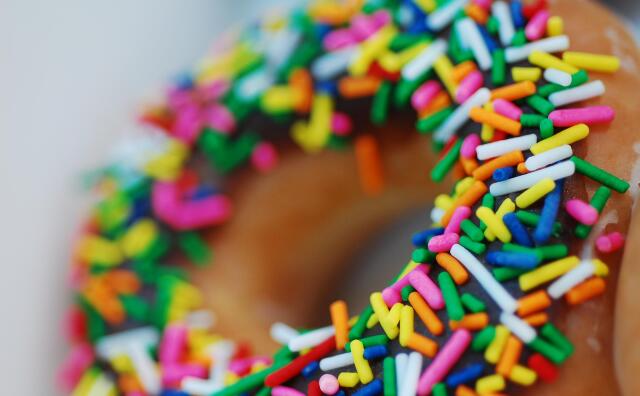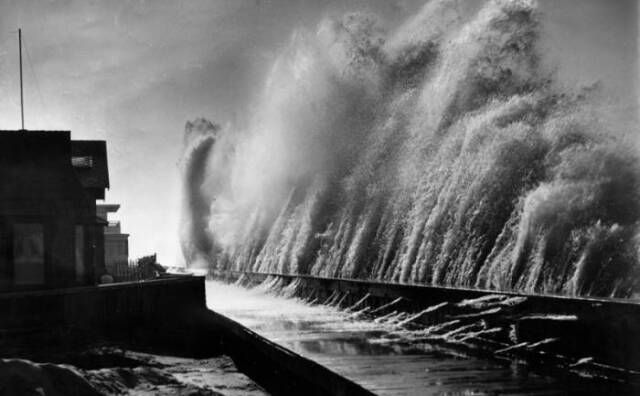For people in post-World War II Los Angeles, drive-in movie theaters were the place to be. You didn't go just to catch the latest blockbuster. You went for the experience.
Drive-ins were all-purpose fun zones that often included swap meets, restaurants, playgrounds and farmers' markets, according to April Wright, director of the documentary Going Attractions.
"A lot of the multiplexes [nowadays] look kind of the same. But if you go to a drive-in, they're all unique. You're there with your family, you're able to talk during the film. It creates a different type of experience," Wright says.

During the 1950s, Los Angeles native Beth Fortmueller spent many a night with her family at the popular Gilmore Drive-In off Fairfax, today the site of The Grove.
"My brother Bill and I would be in our PJs, and our parents would make popcorn and bring Bireley's orange soda," she recalls. "One time, however, in the 4th grade, we went into the snack bar — me in my PJs to help my dad carry everything — and we ran into my teacher, Miss Russell. I was so embarrassed!"

Drive-in theaters flourished in Los Angeles from the late 1940s to the late 1970s. Changing tastes and the reputation of drive-ins as teenage "passion pits" meant that by the 1980s, they had become a rarity.
In the 1950s, the greater Los Angeles area had approximately 70 drive-ins. In 1996, we had around nine. By 2017, that number had shrunk to a single drive-in that was still screening films on the regular.
With the COVID-19 pandemic shuttering traditional movie theaters (and most other forms of entertainment), our Netflixing-and-chilling has reached epic heights. But there's also a countervailing micro-trend, as more people head to drive-in theaters.

Torrance's historic Roadium Drive-In, which opened in 1949 and closed in the mid-'80s, has been hosting family-friendly Drive-In Movie Nights since 2019 while the Paramount Drive-In (in, where else, Paramount) shows a mix of horror and kid flicks.
Local airports are getting into the act. On June 19, the Ontario Airport will kick off Drive-In Movie Nights At Your Airport, converting its empty parking lot into a makeshift drive-in. The auto-centric Ford vs. Ferrari, part of which was shot at ONT, seems like a perfect thematic choice.

An Outdoor Oasis
For a pastime that seems so quintessentially Southern Californian, the drive-in theater wasn't invented in Hollywood but in New Jersey. According to Kerry Segrave, author of Drive- In Theaters: A History from their Inception in 1933, Richard Milton Hollingshead Jr. developed and patented the concept in the early 1930s. On June 6, 1933, the first drive-in theater opened in Pennsauken Township, just outside of Camden.

It was such a success, copycats soon opened around the United States. In Los Angeles, the first permanent drive-in opened on September 9, 1934, at the intersection of Westwood and Pico boulevards. According to Segrave, its first screening was Handy Andy, starring folksy cowboy Will Rogers.

The second L.A.-area drive-in, the San-Val, opened in the San Fernando Valley in 1938. The San-Val could accommodate 618 cars in nine rows and catered to a niche crowd.

"Our patronage is really created by what might be termed a 'non-theatre-going public,'" owner Seth D. Perkins said at the time. "By that, I mean people who are in ill health, cripples, old people, especially large people who find that theatre seats are not comfortable, people who have a fear of contagious diseases... people who have little children whom they dislike leaving at home or in the care of a neighbor or nurse, as well as a good number of people who do not feel like dressing up after a hard day's work."
Nicknamed "ozoners," drive-ins wouldn't take off as a form of mainstream entertainment until the late 1940s, when car culture and the baby boom added millions of automobiles — and children — to the American landscape.
In 1947, when the Vermont Drive-In opened in Gardena, many people had never seen such a thing. According to Frank Diaz, then a 19-year-old usher.
"At the time, nobody knew what to expect. So we let people come in and see what it was all about. About 400 cars came through during the open house — we expected about 100 — and we showed them how to drive in, pull up to a speaker, put it in the car and adjust the sound. Everyone was very excited. We knew we had a winner."

According to Segrave, the number of drive-ins in America went from 102 in 1946 to more than 3,000 by 1954 — and Southern California had a good number of them.
"There will soon be so many drive-ins in California that you'll be able to get married, have a honeymoon and get a divorce without getting out of your car," Bob Hope once quipped.

Movie Memories
The Gilmore opened in what is now the Fairfax district in 1948. Its screen was almost exactly where the Nordstrom entrance is today. It soon became an L.A. institution, part of a complex that included a playground, the adjacent farmers' market and an athletic stadium.
"We used to go to the Gilmore Drive-In all the time," L.A. native Yvonne McLaren recalls. "We had a big station wagon and dad would park it backwards. We'd lift the tail gate and hunker down with pillows and blankets and watch the movies."

It was also a popular hangout for preteens and teenagers, who relished the freedom of a night out on the town.
"My boyfriend and I used to go to the Gilmore Drive-In a lot," Betty Bodelson-Falling says. "It only cost about $1 for each person. Well, we had no money except a box full of pennies... We handed our box of pennies to the attendant, he looked at us, smiled and handed our pennies back and let us go in for free! We laughed so hard at that."
Those without funds had other options. "As kids, we would ride our bikes over to the Gilmore, hop the fence, turn the speakers in the back row up really loud, then climb back over the fence to sit on our bikes to watch the movie," says L.A. native Brian Lally, who grew up across from the Gilmore.

As he got older, Lally ditched the bike for his own wheels.
"I had a 1963 Ford Econoline Van and the front seats weren't bolted. We'd gather some girls and some sleeping bags and blankets and put the seats on the roof. We'd have about 6 of us up there. We'd clamp the speakers to the doors and snuggle," he says.
There was also the old trick of hiding in the trunk to get out of paying the entrance fee.
"One night, our older sister talked me and my other sister into crawling into the trunk, so we'd have more money for popcorn and Cokes," Billie Crofts says. "I made her promise that she would first park in the last row before she opened the trunk to let us out. When she opened the trunk, she had parked smack dab in the middle of the most crowded part of the drive-in. When I lifted myself out of the trunk, dozens of cars turned on their lights and began honking their horns at me."

Drive-ins became notorious necking spots for both teenagers and adults, and fogged up windows were a common sight. Many an Angeleno lost their virginity during a double-feature. Theaters tried to prevent such "immorality" by having security officers patrol the rows of parked cars.
"Parents would rather have their daughters here than up on Mulholland Drive. We patrol but we don't rap on windows," Robert Selig of the Pacific Theatres chain said, according to Segrave's book.
Drive-ins would find their most welcoming home in the San Fernando and San Gabriel valleys, both of which had acres of flat land and thousands of middle-class patrons eager for affordable entertainment. There was The Victory in North Hollywood, the still-kicking Vineland in the City of Industry, and the Van Nuys in... well, Van Nuys (recently recreated in Once Upon a Time in Hollywood).
L.A. area native Don Ormsby remembered in a facebook post:
"My father was a projectionist at many of the drive-ins, most often the Van Nuys. On Saturdays, I would go with him to fix speakers, pushing a wheelbarrow full of tools and new speakers. My mother learned to drive there, maneuvering around speaker posts and up and down over the hills. When we were done, we would invade the empty snack bar and help ourselves to all the stale popcorn and drinks we wanted."

By the 1970s, drive-ins were beginning to lose some of their luster and they became increasingly associated with "bad elements." Many began to show skin flicks.
"The Century Drive-In in Inglewood used to play soft core porn and you could see it from the 405 Freeway — and people would crash," Lally recalls.
As theaters shut down and screens were demolished to make way for housing developments, a few enthusiasts tried to save their favorite venues.
According to April Wright, when The Victory was slated to be torn down in 1977, "There was a preservationist who chained themselves to the top of the screen tower to try to prevent it from being torn down. Of course, it didn't work."
The Gilmore closed in 1979, echoing a trend happening around the United States.
"The number of drive-ins plummeted downward through the 1980s. From a peak of 4,063 in 1958 to 2,882 in 1977 to 2,129 in 1982 to 999 in the 1987 census," Kerry Segrave writes in Drive- In Theaters.

During the 1990s and early 2000s, drive-ins were replaced by large, indoor megaplexes with stadium seating, air-conditioning and multiple showtimes. According to Steve Harvery of the Los Angeles Times, by 2012, only The Vineland in the City of Industry was regularly showing drive-in movies in Los Angeles County. But Los Angeles has seen a resurgence of interest in drive-in theaters during the past few years.
Some Angelenos have begun travelling to San Bernardino County to view films at the historic Mission Tiki, or to Riverside County's Rubidoux and Van Buren theaters. Rooftop and pop-up screenings abound. COVID-19 has given all of that an extra push.
"What's changed is that awareness of them has vastly increased because they're basically the only show in town. Now, drive-ins are being contracted to do concerts. They're also booking graduations, weddings, church services and stand-up comedy," Wright says.

Screenwriter Samantha Herman, who calls herself a "hardcore movie junkie," was so desperate to see a movie on the big screen, she recently drove from West Hollywood to Mission Tiki in Montclair, where she met up with two friends who had come in their own cars.
"It felt like a way to be somewhere, anywhere, and engage with the world, but within the confines of a safe space. I was able to bring my own snacks and my own radio and not have to worry about physical distancing or safety practices. As I drove there, I was filled with an unhealthy level of excitement," Herman says.
She discovered she wasn't the only person who had come to see the Valley Girl/Trolls World Tour double feature. "I was surprised at how diverse the crowd was, as far as age, young and old, and as far as group dynamics, singles, families and friends," Herman says.
Plus, the drive-in allowed hundreds of Angelenos to get together while staying safely apart.
"The combination of watching a new movie on a screen bigger than my own TV plus the sensation of being a part of society again, legitimately moved me to tears," Herman says. "It was the happiest I had been since quarantine had started, and that's probably still true a month later. I can see how others might have felt it was kitschy but for me, there was no irony."







